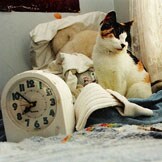---------- Forwarded message ----------
From:
The Daily Vet <thedailyvet@petmd.com> Date: Mon, Feb 21, 2011 at 5:20 AM
Subject: Are Your Cats Keeping You Up at Night?
To:
jliebmannsmith@gmail.com
 | | February 21 |  |
|  Recently, I came across the results of a survey that asked cat owners whether their pets kept them up at night. The results weren't too surprising considering that domestic cats evolved from wild ancestors in Africa where being active during the hottest parts of the day is downright foolish. Fifty-five percent of the people responding reported that their cats were more active during the night than during the day. Thankfully, the majority (76 percent) of these folks said they were able to sleep through their cat's antics, but my heart goes out to the remaining 24 percent who are routinely woken up by their cats. I'm sure we've all been in their shoes for one reason or another and can agree that it is next to impossible to be at your best when you're chronically sleep deprived.
If you are reading this through the steam of your umpteenth cup of coffee while your cat dozes peacefully on the couch recovering from her feline "all-nighter," take heart. Cats can learn to follow a more people-friendly schedule.
Kittens are the worst offenders. Since they have little experience in the human world they simply follow their instincts, sleeping all day and then pouncing on your nose or scampering across your feet in an attempt to get you to play in the middle of the night. Although it is admittedly difficult in the pre-dawn hours, try to remember that any cat that is active at night is not being "bad." She is simply following her natural circadian rhythm. Negative reinforcement (e.g., yelling or any form of punishment) should play no role here. Your best response is to completely ignore this behavior.
Of course, ignoring nighttime activity is a whole lot easier if your cats are not in your bedroom. Restricting pets to another part of the home while you are sleeping is a good option. They may cry or scratch at the door, but most will give up if you never respond in any way while they are carrying on. You can also use baby gates (one stacked on top of another to keep cats from jumping over), scat mats, or motion-activated devices that let out a harmless but startling puff of air to keep pets away from the sleeping quarters.
If your cats want you to get up and feed them during the night, get an electronic food bowl that you can program to open up in the wee hours or hide small piles of food throughout the house before you retire for the evening. Make sure you keep your cat's overall food intake at an appropriate level, though.
The next phase of the retraining program is to get your cat up and active during the day. Schedule some play time with your cat. Use interactive toys like kitty fishing poles, laser pointers, or even just a crumpled up piece of paper that you can throw or cardboard box that you can push across the floor. When you have to be gone for long periods during the day, try putting a cat video on the TV, placing a perch by the window with a view to a bird feeder, or even asking a neighbor to stop by and play with your cat for a while.
If an older cat that previously left you alone at night is now getting you up, talk to your veterinarian. Hyperthyroidism, hypertension, diabetes mellitus and some other very serious diseases can change your cat's behavior and activity levels, and you need to rule these out before you start down the path of behavior modification.
So, if you are an involuntary member of this sleep-deprived, cat-owning club, take heart. With time and a little perseverance you should be able to convince your cat that nighttime is the right time to sleep. Sweet dreams! 
Dr. Jennifer Coates Pic of the day: Le archives: Sage と Winston by Debs 
|
All opinions are welcome on The Daily Vet. So bark away... we don't bite. |
|
|
--
Joan Liebmann-Smith, Ph.D.
105 W. 72nd Street 11A
New York, NY 10023
Tel: (212) 787-6333
cell: 646-246-1952
www.babybodysigns.com www.bodysignsbook.com





















